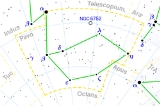
Alpha Pavonis
Encyclopedia
Alpha Pavonis is a star
in the constellation
Pavo
. It is also known by the name Peacock, which was assigned by Her Majesty's Nautical Almanac Office in the late 1930s during the creation of the Air Almanac, a navigational almanac for the Royal Air Force
. Of the fifty-seven stars included in the new almanac, two had no classical names: Epsilon Carinae
and Alpha Pavonis. The RAF insisted that all of the stars must have names, so new names were invented. Alpha Pavonis was named "Peacock" ('pavo' is Latin for 'peacock') whilst Epsilon Carinae was called "Avior".
The star has been found to be a spectroscopic binary star
.
Star
A star is a massive, luminous sphere of plasma held together by gravity. At the end of its lifetime, a star can also contain a proportion of degenerate matter. The nearest star to Earth is the Sun, which is the source of most of the energy on Earth...
in the constellation
Constellation
In modern astronomy, a constellation is an internationally defined area of the celestial sphere. These areas are grouped around asterisms, patterns formed by prominent stars within apparent proximity to one another on Earth's night sky....
Pavo
Pavo (constellation)
Pavo is a constellation in the southern sky. Its name is Latin for peacock. It is one of twelve constellations created by Petrus Plancius from the observations of Pieter Dirkszoon Keyser and Frederick de Houtman and it first appeared on a 35-cm diameter celestial globe published in 1597 in...
. It is also known by the name Peacock, which was assigned by Her Majesty's Nautical Almanac Office in the late 1930s during the creation of the Air Almanac, a navigational almanac for the Royal Air Force
Royal Air Force
The Royal Air Force is the aerial warfare service branch of the British Armed Forces. Formed on 1 April 1918, it is the oldest independent air force in the world...
. Of the fifty-seven stars included in the new almanac, two had no classical names: Epsilon Carinae
Epsilon Carinae
Epsilon Carinae is a star in the constellation Carina. At apparent magnitude +1.86 it is one of the brightest stars in the night sky, but is not visible from the northern hemisphere....
and Alpha Pavonis. The RAF insisted that all of the stars must have names, so new names were invented. Alpha Pavonis was named "Peacock" ('pavo' is Latin for 'peacock') whilst Epsilon Carinae was called "Avior".
The star has been found to be a spectroscopic binary star
Binary star
A binary star is a star system consisting of two stars orbiting around their common center of mass. The brighter star is called the primary and the other is its companion star, comes, or secondary...
.

